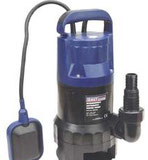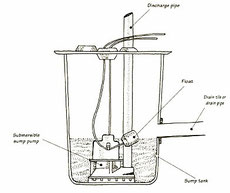Sump pit and Sump pumps used for Garden drainage.
I have an opportunity for a self employed garden drainage specialist to take on leads information
What is a sump pit?
How to build a garden drainage sump pit bottom of page.
What is a sump pit pump?
D.I.Y information below or contact Mike drainage services

Information about Submersible sump pumps
- A sump pump, is a submersible pump with a built in float switch that automatically cuts the power to the pump when there is no water left to pump.
- Purpose, used for pumping out water that is being drained into a sump pit from a French drain system.
- Dirty water the pump should always be able to pump dirty water - this means water containing grit, sand, mud and small pebbles.
- On/Off switch. It's always best to fit a submersible sump pump with a controller, normally a plastic or rubber floater that automatically switches on and off as the water rises and falls.
- Sump-cover. It's also a good idea to fit a strong removable cover over the sump pit for easy access to the sump pump and to stop the kids falling into the sump.
- Discharge hose. You will also need to connect a hose to the pump to pump the rainwater into the surface drainage system. The sump pump hose can be run over the top of the lawn or garden to connect into the surface water drainage system, but can be a nuisance when mowing the lawn or even a hazard for kids playing on the lawn. The pump hose is best buried under the garden or lawn.
If the discharge hose is to be laid under the surface.
Hose specification and fittings for discharge hose to be buried
- You will need a reinforced Flexible Hose and connector that matches the pump outlet,
- Hose clips and connector to join additional lengths of hose if required.
- The hose will need to be long enough to run from the pump to the discharge area.
- A non return valve fitted to the hose to stop the water flowing back into the sump pit wasting electricity.
- Once you have purchased the pump, I recommend contacting a specialist discharge hose supplier who will be able to advise on the correct "underground" hose fitted with a non return valve to fit your pump.
Discharge hose laid over the surface.
- A simple "lay flat" hose can be used if the hose runs over the surface of the lawn and is not buried.
- Measure the run, that's the distance from the sump pit to the discharge point,
- Measure the rise, that's the height difference between the sump and the point the water is to be pumped too, add this figure to the run figure.
- Check the pump has an on off switch.
- The two sump pumps I have selected below are pumps I have used when installing drainage and meet all the criteria, I/E rise, pumping distance, dirty water and automatic on off switch.
I use the 52066 sump pump below for pumping dirty water over long distances from the sump to a drain. Costs a bit more, but will last a lot longer.
Sump pit pumps and discharge hose to purchase now
Sump pump under £250
Draper submersible dirty water pump with float switch.
Designed for heavy-duty applications such as, pumping out sump pits over a long distance, inspection pits, ditches and footings where solids may be present as well as general irrigation. Ceramic shaft for long life, thermal overload protection and float switch which automatically turns the pump off when water level has dropped. Supplied with 10 m (approximately) of cable and approved plug.
Draper 73171 10 m x 38 mm Lay flat Hose
Designed for use with the Draper submersible water pumps featured here.
This High capacity 10m discharge hose is compatible with submersible pumps when running the hose over the surface and can be purchased with the pump.
technical information to help select a suitable drainage sump pump.
When selecting a pump you need to measure the height difference between the sump and the point the water is to be pumped too. The head of the pump must be at least 25% greater than that measured distance.
The flow rate is a measure of the amount of water that can be pumped by the pump. This flow rate falls when water is pumped upwards.
For D.I.Y. make sure the pump you purchase is made for the job. Check it switches on and off automatically and can pump dirty water over the distance you have measured from the sump pit to the surface water drain. The pumps featured in this article (above) are the sump pumps I regularly use. Mike
Sump discharge Hose and accessories.
-
You will need a reinforced Flexible Hose and connector that matches the pump outlet,
-
Hose clips and connector to join additional lengths of hose if required. The hose will need to be long enough to run from the pump to the discharge area.
-
A non return valve fitted to the hose, this stops the water flowing back into the sump pit, wasting electricity.
-
A "lay flat" hose can be used if the hose runs over the surface of the lawn and is not buried.
-
If you are burying the hose once you have purchased the pump, contact a specialist discharge hose supplier who will be able to supply the correct hose fitted with a non return valve to fit your pump.
How to build a sump pit for draining a waterlogged garden.
If you have a waterlogged garden or lawn, as described on my garden drainage page and can't drain the water into the surface drainage system because the garden slopes away from a suitable discharge point. A sump pit and pump at the lowest part of the French drainage system is your best option. These systems are cost effective, low maintenance and activate automatically to remove the water.
This is how to construct the sump pit
Tools needed to build a sump are a spade, cement, spirit level, tape measure available from the drainage shop
-
Work out the best place to dig the sump pit. This will be the lowest point of your garden or lawn and always where the surface water puddles. Remember you are connecting French drains and water will not travel uphill.
-
Dig the sump pit 27 to 36 inches deep and 24 inches square to allow for the concrete lining. Check the sides are smooth and free from rocks or roots and the bottom is level.
-
Build a wooden frame to fit inside the pit, leaving enough space for 3" of concrete to be poured behind and around it.
-
Pour in concrete behind the frame to form the walls of the garden drainage sump, allowing at least 3 inches on all four sides. The top should be level with the lawn or a couple of inches below if you want to hide the lid under decorative gravel. Add a small strip of 1-inch wood to the top edge of the frame. When the concrete dries this will form a lip around the top of the sump pit to support the cover.
-
Allow the concrete to set for a minimum of 24 hours and then remove the frame or leave it in place. The frame will eventually rot away and be easier to pull out of the sump.
-
Fill the bottom 4" with at least 20m gravel. Pea gravel could block the sump pump.
-
Fit the sump cover.
- Dig out the first part of the trench leaving a section of soil about 6 inches thick to hold the concrete back.
- Pour in the concrete and let it partly set.
- Tap a section of the right size pipe through the earth and soft concrete, until it hits the timber frame.
- Let the whole thing set and remove the frame and section of pipe.
Common mistakes when building a sump pit
- Make sure the pipe is set at the bottom of the trench, but high enough up the sump pit to allow room for the pump and float.
- Fit a wire filter over the trench side of the pipe to stop gravel falling through. This can be made from chicken wire.
- Do not concrete the floor of the pit, the more water that soaks away the less electricity you will use.
- If you plan for more than one trench to drain into the sump, if the slopes allow, connect them into the main trench, it's easier than trying to connect them all into the sump.
Drainage services in Somerset, Devon, Dorset, Hampshire, Surrey, Berkshire, Oxfordshire, Gloucestershire, Buckinghamshire, Wiltshire, Midlands, South Wales, West London, North and Central London.

